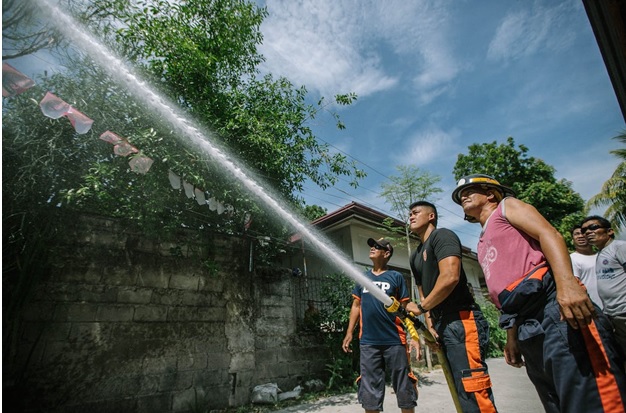Vacuum Breakers: Types, Operation, and Purpose
Nov 9th 2023
Keeping potable and non-potable water separated, as well as protecting potable water supplies against potential contamination, are two of the most important aspects of consideration in commercial plumbing.
One device that protects against two threats that can result in contamination of a potable water supply arising from backflow or backsiphonage is known as a vacuum breaker. Here’s what you need to know.
Protecting Against Backflow and Backsiphonage
Backflow is one of the most dangerous conditions that can occur within a plumbing system, in which water flows in the opposite direction from which it is intended. Imagine water flowing back up into a faucet or showerhead, instead of out; that’s what happens in a situation in which there is backflow.
Normally, water line pressure keeps water flowing only in the right direction. However changes in pressure in the plumbing lines that create a vacuum can cause water to flow in the wrong direction. When this happens, unclean water can mix with clean, potable water, creating a dangerous condition for those that rely on a clean water source, such as for drinking water.

Backflow can occur as a result of many different factors. Backflow can occur whenever there is a drastic drop in water pressure, such as when a water main bursts or when a fire hydrant is opened and under heavy draw. These can create dangerous conditions in which contaminated water is drawn into pipes intended to convey potable water.
Backsiphonage is a similar condition, which results in the reversal of normal or intended flow of water through pipes. It can also be caused by vacuum or partial vacuum conditions. Effectively the same conditions can cause backsiphonage that cause backflow, such as when there is a heavy draw on the water supply or a break in the water main.
Types of Vacuum Breakers
One of the most basic ways to protect contamination across different water supplies is by creating an interposing gap of air between the two. These can also be supplemented by means of mechanical sequestration.
Vacuum breakers are among the most effective devices at preventing backflow and backsiphonage that can imperil a potable water supply. In a nutshell, vacuum breakers are a type of backflow preventer that keeps water from flowing backward through the pipes. There are many different types of vacuum breakers, some of which are detailed below.
● Atmospheric vacuum breakers:
Atmospheric vacuum breakers, also known as AVBs, are a common type of breaker used to prevent backflow. These consist of a check valve and an air vent that is closed when the device is under normal line pressure.
The air vent allows air into the system which can stop backflow if the pressure ever drops. They are relatively simple in their design but have a few requirements to ensure that they operate properly.
They are intended to provide protection at point of use, not at point of service, so service lines do not contain AVBs. It is also important to note that an AVB must not be subjected to more than 12 hours of continuous pressure. If it is, the valve can become stuck and may not open as needed.
Valves cannot be permitted downstream of AVBs, and they cannot be subjected to backpressure or they will not function as intended. AVBs much also be installed upright, as they rely on gravity to function properly.
● Pressure vacuum breakers:
Because an AVB has the limitation that it cannot be subjected to continuous backpressure, its utility is limited. The fact that the valve can also become stuck is another concern. These potential drawbacks have necessitated the development of other types of effective backflow prevention measures. One of these is a pressure vacuum breaker, or PVB.
Whereas the AVB’s check valve operates in the presence of pressure, the PVB’s check valve is spring-loaded. PVBs, unlike AVBs, can operate properly in the presence of continuous pressure without malfunction. The springs of the internal check valves prevent them from becoming stuck when pressure is applied for prolonged periods of time, even in the presence of mineral accretion or fouling.
Therefore, the continuous pressure restriction on AVBs is lifted and PVBs can be installed in those situations, even indoors, so long as outlet pressure never exceeds inlet pressure.
● Spill-resistant vacuum breakers:
A spill-resistant vacuum breaker, also known as an SVB, is another iteration of the PVB, and one in which water spillage is mitigated.
In a pressure vacuum breaker, the check valve and air inlet must operate independently of each other. With an SVB, this is not the case. In the operation of an SVB, the valve chamber closes before the internal check valve opens, allowing the air inlet to be closed when the check valve opens again. This helps limit spilling associated with PVBs.
● Hose connection vacuum breakers:
Hose connection vacuum breakers, or HVBs, should be installed on each hose bibb that is connected to a potable water supply to prevent backflow into the supply. They should also be installed a minimum of 6 inches above the ground. These are typically required to be installed per applicable plumbing codes.

An HVB is actually a type of AVB that vents water to the atmosphere (and to the ground) when backflow conditions occur. Therefore, they allow any backpressure to vent out of the hose bibb before it reaches the potable water supply.
The HVB contains a spring-loaded check valve that opens during normal operation. When the pressure is reversed, and pressure in the hose is higher than the pressure at the point of outflow, this counters against the spring-loaded check valve and closes it, at the same time opening a vent to the atmosphere which releases the backflow and ports it out and onto the ground.
Top-Quality Vacuum Breakers and Repair Kits
We carry a wide range of vacuum breakers and kits, as well as commercial plumbing parts from Kohler, Woodford, Zurn, American Standard, Arrowhead, and many others.
Take a look through our collection and get in touch with us at 1-833-251-4591 if you have any questions about our parts or kits.

